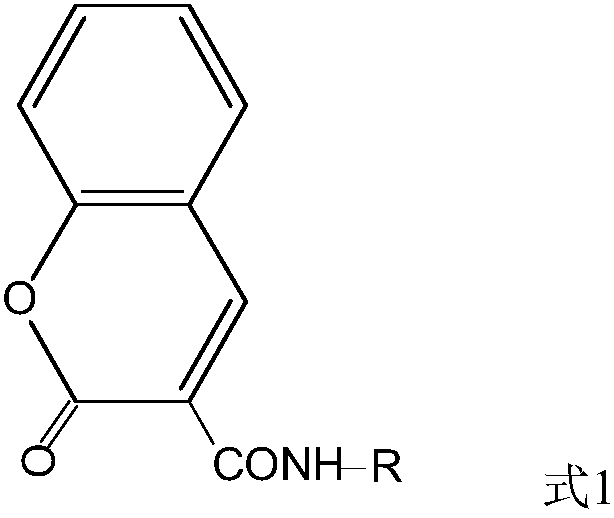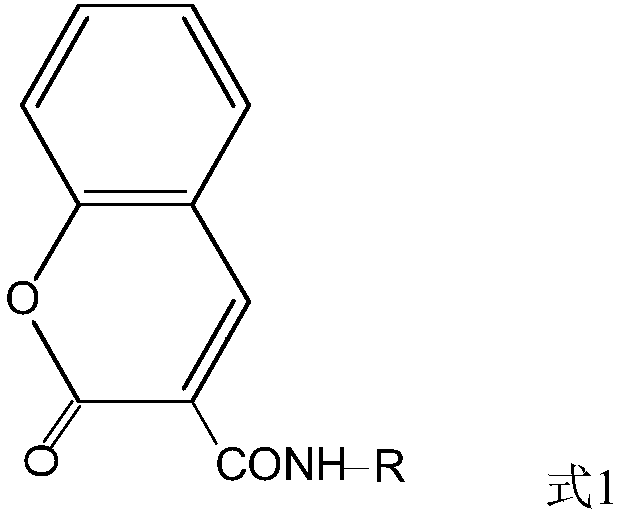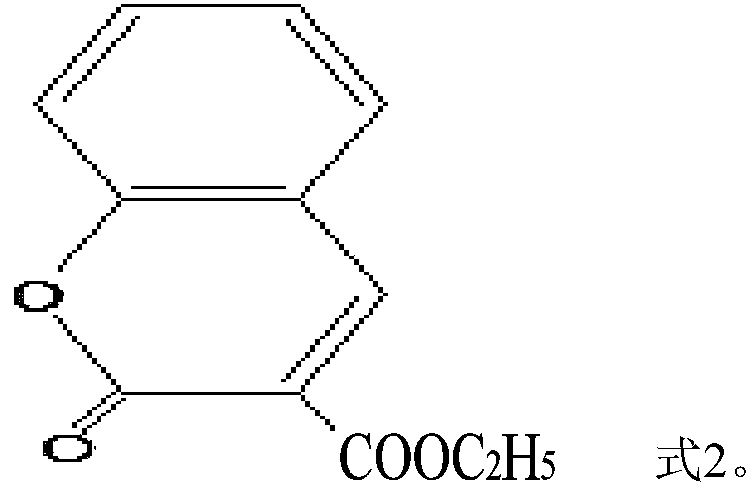Aqueous fluorescent tracer and preparation method thereof
A fluorescent tracer, water-based technology, applied in the field of fluorescent tracers, can solve the problems of unfavorable large-scale popularization and application, complex analysis and testing methods, poor adaptability and selectivity, etc., and achieve easy monitoring and analysis, simple structure, and thermal stability Good results
- Summary
- Abstract
- Description
- Claims
- Application Information
AI Technical Summary
Problems solved by technology
Method used
Image
Examples
Embodiment 1
[0044] This embodiment provides a kind of aqueous fluorescent tracer, the preparation of this aqueous fluorescent tracer comprises the following process:
[0045] 1) Mix 10.5 parts of salicylaldehyde, 21 parts of diethyl malonate, 50 parts of absolute ethanol, 0.8 parts of hexahydropyridine and 0.01 part of glacial acetic acid, stir and reflux at 78°C for 2 hours;
[0046] 2) Cool to room temperature after reflux, add 6 parts of cold water (the temperature of cold water is 5-25°C) to the reaction product, suction filter after crystallization, and cool with 1 part of ice water, and then use 60% ethanol with a mass fraction of Solution washed 2 times;
[0047] 3) Recrystallize with an ethanol solution with a mass fraction of 25%, and obtain the first product after drying;
[0048] 4) After mixing 2.2 parts of the first product above, 2 parts of potassium hydroxide, 20 parts of absolute ethanol and 10 parts of water, heat to 78°C and reflux for about 1.5 hours; pour the reaction p...
Embodiment 2
[0055] This embodiment provides a kind of aqueous fluorescent tracer, the preparation of this aqueous fluorescent tracer comprises the following process:
[0056] 1) Stir and reflux 10.5 parts of salicylaldehyde, 21 parts of diethyl malonate, 50 parts of absolute ethanol, 0.8 parts of hexahydropyridine and 0.01 part of glacial acetic acid at 78°C for 2 hours;
[0057] 2) Cool to room temperature after reflux, add 6 parts of cold water (the temperature of cold water is 5-25°C) to the reaction product, suction filter after crystallization, and cool with 1 part of ice water, and then use a mass fraction of 50% Wash with ethanol solution 3 times;
[0058] 3) Recrystallize with an ethanol solution with a mass fraction of 20%, and obtain the first product after drying;
[0059] 4) After mixing 2.2 parts of the above-mentioned first product, 2 parts of potassium hydroxide, 20 parts of absolute ethanol and 10 parts of water, heat to 75 and reflux for about 1.5 hours; pour the reactio...
Embodiment 3
[0066] This embodiment provides a kind of aqueous fluorescent tracer, the preparation of this aqueous fluorescent tracer comprises the following process:
[0067] 1) After mixing 10.5 parts of salicylaldehyde, 21 parts of diethyl malonate, 50 parts of absolute ethanol, 0.8 parts of hexahydropyridine and 0.01 part of glacial acetic acid, stir and reflux at 78°C for 2 hours;
[0068] 2) Cool to room temperature after reflux, add 6 parts of cold water to the reaction product (the temperature of cold water is 5-25 ° C), suction filter after crystallization, and cool with 1 part of ice water, and then use 45% ethanol with a mass fraction Solution washed 4 times;
[0069] 3) Recrystallize with an ethanol solution with a mass fraction of 30%, and obtain the first product after drying;
[0070] 4) Heat 2.2 parts of the first product above, 2 parts of potassium hydroxide, 20 parts of absolute ethanol and 10 parts of water to reflux at 80°C for about 1 hour; pour the reaction product i...
PUM
 Login to View More
Login to View More Abstract
Description
Claims
Application Information
 Login to View More
Login to View More - R&D
- Intellectual Property
- Life Sciences
- Materials
- Tech Scout
- Unparalleled Data Quality
- Higher Quality Content
- 60% Fewer Hallucinations
Browse by: Latest US Patents, China's latest patents, Technical Efficacy Thesaurus, Application Domain, Technology Topic, Popular Technical Reports.
© 2025 PatSnap. All rights reserved.Legal|Privacy policy|Modern Slavery Act Transparency Statement|Sitemap|About US| Contact US: help@patsnap.com



